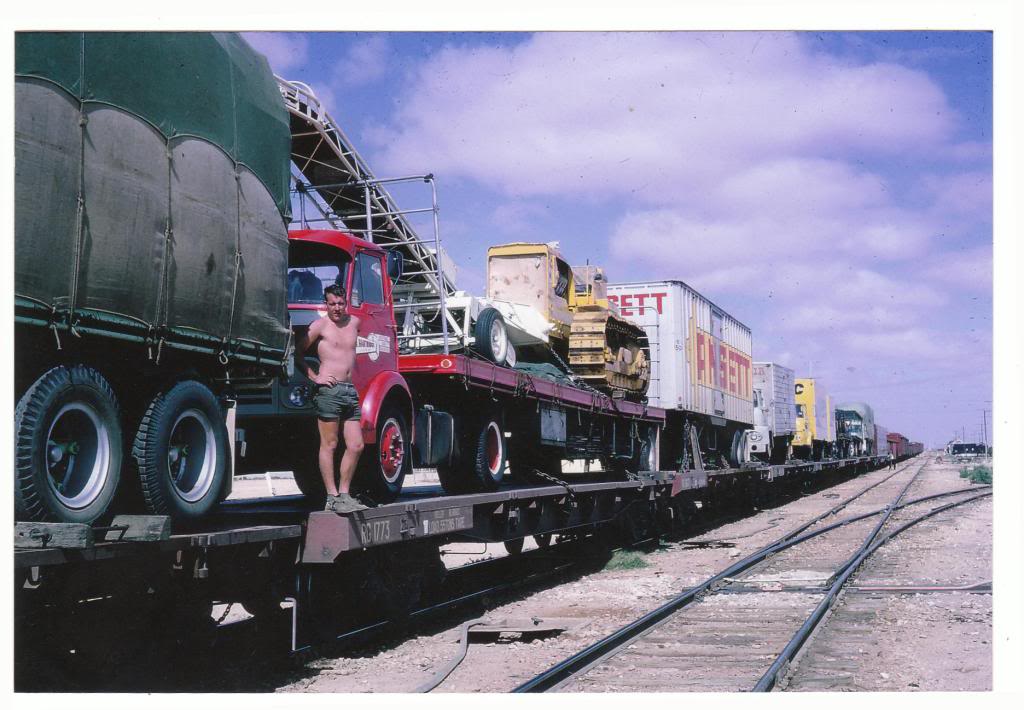
The Nullabor Truck Train 
The Commer on the Truck Train
With the opening of the final stretch of sealed road between Adelaide and Perth, in the mid 1970’s, an era of Australian transportation received its death sentence – The Truck Train, from Port Augusta to Kalgoorlie. Prior to this the state of the Eyre Highway across the barren Nullarbor Plain varied between bad and atrocious and it is amazing that a nation as wealthy as Australia allowed the country to be cut in two with no reasonable road connection for so many years.
The only trucks willing to brave the bone jarring 2,000 kilometre journey were those carrying absolutely unbreakable cargo such as steel. But, although the cargo may have been unbreakable, the trucks were not, and many a driver finished the journey well out of pocket after repairs to the truck and trailer. Suspensions collapsed, tyres burst, chassis cracked and the engines overheated in the forty plus temperatures. The seas of bulldust disguised pot holes half a metre deep and hitting one of these death-traps at speed meant the likely finish to the journey, 200 kilometres from the nearest help. The few drivers who attempted the Nullarbor with fragile cargo had little chance of convincing the insurance company that load damage was reasonably caused.
To overcome the problem of keeping the Western Australian population supplied with goods required for the booming development in that state in the late fifties and sixties, the Commonwealth Railways provided a train between Kalgoorlie and Port Augusta, daily in each direction, dedicated solely to carrying semi-trailers.
About mid-day up to 40 trucks would gather in the goods yard of the Port Augusta railway station after overnight runs from Melbourne, Sydney and Brisbane then commence loading in a flurry of activity. The flat-top cars had narrow steel tracks placed between them and the entire train was backed up to a ramp. The first truck was obliged to travel the entire length of the train across 30 or more of those little bridges and, as the truck and the train were both 2.4 metres wide, it was a slow and delicate process as the driver maneuvered his vehicle several hundred metres with the wheels centimetres from the edge of the rail cars.
As soon as the first truck had gone a short distance the next would start and fairly soon there were a dozen or so semi-trailers performing their acrobatic journey along the length of the train. Each truck was accompanied by a couple of railwaymen who shouted instructions as the vehicles came to close to the edge. With all the shouting, trucks revving and horns tooting, the loading took on the appearance of a giant circus packing up to move to the next town. As soon as each truck arrived on the assigned flat-car the railwaymen would swarm around underneath and, disregarding such modern equipment as chains and turnbuckles, wrap lengths of large manila rope around the truck axles and tighten the rope by twisting it with a length of wood which was then secured with a turn of wire. As crude as this may seem, I have never heard of a truck coming loose and no doubt the strength in the rope put much less strain on the truck than chain during the, sometimes bumpy, 36 hour journey across the desert.
Once the trucks were secured the drivers would head for town to stock up on supplies, for the Commonwealth Railways supplied nothing. Wandering back to the train in the late afternoon they would board the only carriage, right at the back of the line of trucks, and find a bunk in what had previously (about 30 years ago) been a first class sleeping car. The carriage had been modified to include an equipped kitchen and several showers and toilets but of course there was no air conditioning, steward service or bar.
Towards evening the drivers would hear the dreaded noise which would plague them for the next day and a half as the tandem locomotives gave a blast on the whistle and took up the slack in the couplings which individually were quite small. But the accumulated slack in fifty sets of couplings meant the engine was travelling at some considerable speed while the crew car was still stationary way down the back. The drivers braced themselves as the “Clang – Clang – Clang” raced towards them down the length of the train. At last the coupling in the crew carriage took up and those lucky enough to be seated were thrown back in their seats. Anyone having a shower finished on the floor with the soap while new chums, cooking an early meal, watched their dinner fly off the stove onto the kitchen floor. If it was an old hand who was cooking he would have removed his saucepan at the first “Clang” and braced himself, dinner in hand, against the kitchen wall.
The Nullarbor concertina worked in both directions and the engines would be stationary at a siding while the crew car was still gaily travelling along at a cruising speed while the occupants listened to what sounded like a rapid fire antiaircraft gun speedily approaching. The amount of pain was not constant for each trip and some of the engine drivers were remarkable in the way they delicately took the strain with a minimum of jerking. Within half an hour of departure the passengers knew just how good or bad the trip would be.
Not all the journey was uncomfortable and not many hours after departure the train was moving very slowly through red sand-hills in the cool of the evening – a great relief from the usual oppressive heat of Port Augusta. The tracks in this area were very unstable due to the sand base with a winding path around the hills and it was not uncommon for travellers to look upon the railway trucks (particularly tankers with their high centre of gravity) strewn upside down alongside the line. The engine-drivers took particular care with the truck trains and accidents with these were seldom heard of.
The drivers usually spent the first night yarning, cooking their meal or sleeping off the effects of the afternoon session at a Port Augusta pub. All through the night everyone was woken by violent stops and starts as the truck train pulled into sidings to allow the speedy Indian-Pacific passenger trains to pass or another freight train to clatter from the opposite direction. The stops were long enough for the drivers to wander along to check on their trucks as there was little chance of the train leaving them behind with the warning of the crashing concertina and most would wait for the crew car to come up to them and leap aboard as it slowly accelerated past.
The following day would be spent travelling across the treeless expanse of the Nullarbor Plain with the horizon hidden by a shimmering heat haze and regular stops being made at tiny railway settlements named after Australian Prime Ministers. These hardy settlers live in a featureless desert, hundreds of kilometres from their neighbours , maintaining vast lengths of track (including the longest stretch in the world without a bend – 478 kilometres) with only the goods trains as a link between them and civilization. At one settlement there was a golf course, naturally without a single blade of grass, where the golfers were obliged to paint their golf balls a bright colour, for the fairways were completely covered in white gypsum rocks about the size of a ball. The greens had been picked clean of rocks and were smooth light brown sand.
The drivers would spend the day playing cards or lying in their bunks reading and sweating. The highlight was when the truck train from Kalgoorlie passed from the opposite direction with the occupants hanging out the windows greeting friends or calling out what “loading” was like in Perth. This snippet of information was vital, as the freight going to Perth was vastly greater than that coming back to the Eastern states and about half the trucks on the Kalgoorlie train were empty, and the drivers having made enough on the way over or given up in disgust waiting for a load in Perth and returned to the more lucrative East, taking a loss on the journey. Those with loads were only receiving about one third of the price they had obtained for the westbound freight, such were the rigours of supply and demand.
On a regular basis the train would make an unscheduled stop at a small settlement and there would be much activity as the railwaymen scoured the trucks and came back down the line with a hitch-hiker who had taken advantage of the slow speed of the truck train to leap aboard and get free passage across the Nullarbor hiding in the back of one of the semi-trailers or, if particularly brazen, sitting up comfortably in the truck cab. This criminal activity, as old as railways themselves, was looked upon as something of a sport by the railwaymen and I doubt if the culprits ever suffered serious punishment. The attitude changed considerably when, shortly after the introduction of cargo containers, a hitch-hiker was crushed to death when a container, in front of which he had been hiding, slid forward. So violent had been the impact that the drivers could see the outline of a human form on the end of the container as they went past to collect their vehicles.
The second evening was the highlight of the trip and often the railwaymen tried to leave an empty flat top carriage in front of the crew car. The drivers would take a chair and jump the gap between the carriages and sit in the cool breeze looking at the completely cloudless, star studded sky and the moonlit desert as it glided past at 60 kilometres per hour. These few hours were almost justification for the whole trip.
About mid morning the train would pull into Kalgoorlie whose great mullock heaps and wheels and towers over the gold mines had been visible for some time. Once again the circus would go into action and within a very short time of shouting and noise the trucks would be streaming out of town towards Perth with the aim of being first unloaded the next morning to be best positioned for a return cargo. Meanwhile the trucks waiting at Kalgoorlie were being gently driven along the flat tops to be prepared for the eastbound journey. A large part of Australian transport history died with the sealing of the Eyre Highway and the introduction of cargo containers as this was one of the few times the two main forms of land transport combined smoothly to achieve an aim. It is a pity that the lessons learnt from this co-operation over many years have been forgotten to the detriment of the nation
